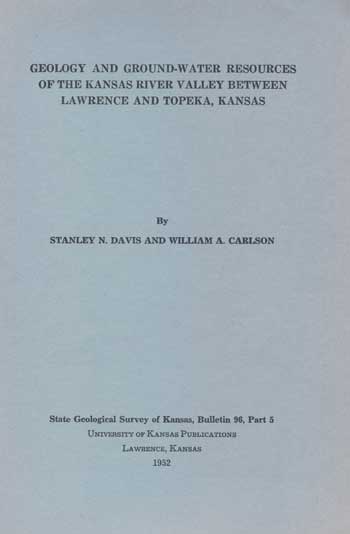Geology and Ground-water Resources of the Kansas River Valley between Lawrence and Topeka, Kansas
By Stanley N. Davis and William A. Carlson

Originally published in 1952 as Kansas Geological Survey Bulletin 96, part 5. This is, in general, the original text as published. The information has not been updated.
Abstract
The Kansas River Valley between Lawrence and Topeka is an important industrial and agricultural area in eastern Kansas. Both Topeka and Lawrence are built principally on the south bluffs of the valley. The valley is divided topographically into flood plain and Newman terrace. An old dissected terrace is preserved in many places along the margins of the valley, and in other places steeper bedrock escarpments flank the valley.
Limestone, shale, siltstone, and sandstone of Pennsylvanian age crop out in the mapped area and dip gently westward. These rocks are the source for small but important quantities of domestic water. Unconsolidated Pleistocene sediments are the only other rocks exposed. Earliest Pleistocene sediments are small deposits of pre-Kansan and early Kansan sands and limestone-chert gravels. Till and outwash of Kansan age are widespread north of Kansas River. Till is impervious and adversely affects groundwater motion, but outwash gravel supplies water to a few wells and to two springs. Colluvium and terrace deposits of post-Kansan age are present along tributaries to the main valley but are not important sources of water. Late Wisconsinan and Recent alluvial fills are the only sources of large quantities of water. In the Kansas River Valley the alluvium reaches a maximum thickness of 89 feet.
Industry uses about 75 percent of the 12,852,000 to 15,552,000 gallons of water pumped from wells daily. Use for irrigation ranges from none to more than 2,500,000 gallons a day, quantity depending upon time of year and precipitation. Municipal use is about 3,000,000 gallons of water a day. Wells near the river receive direct recharge by river water, but the main alluvial fill is recharged by rain water and water draining from the uplands. No shortage of ground water exists and proper spacing of future wells will allow substantial increase in the amount of ground water available for utilization in the area. Quality of the water is generally good, the most objectionable property of the water being a high carbonate hardness which is a common constituent of most well water in central United States.
Well logs, water-table measurements, chemical analyses, and well yields are tabulated. Maps, cross sections, and profiles present other ground-water and geologic data.
Kansas Geological Survey, Geology
Placed on web April 10, 2012; originally published June 1, 1952.
Comments to webadmin@kgs.ku.edu
The URL for this page is http://www.kgs.ku.edu/Publications/Bulletins/96_5/index.html